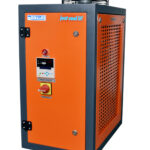Refrigerated Air Dryer
Refrigerated Air Dryer is a type of device used in compressed air systems to reduce the moisture content of the air. It operates by cooling the compressed air to a temperature where water vapor condenses into liquid water. This condensed water is then separated from the air stream and drained out, leaving dryer air to continue through the system. Refrigerated air dryers are essential in industrial applications where moisture can damage pneumatic equipment, cause corrosion, or affect product quality. They help maintain consistent air quality and prevent operational issues related to moisture in compressed air systems.

Refrigerated Air Dryer
Components of
- Air-to-Air Heat Exchanger (Air-to-Refrigerant Condenser): This component cools the incoming warm and moist compressed air using outgoing cold and dry air or refrigerant, facilitating heat exchange.
- Refrigeration Compressor: It compresses and circulates the refrigerant through the system, raising its pressure and temperature for effective heat removal.
- Air-to-Refrigerant Evaporator: The evaporator allows the refrigerant to absorb heat from the warm compressed air, causing moisture to condense and separate from the air stream.
- Condensate Separator: This separates the condensed water from the cooled air, allowing it to be drained or removed from the system.
- Condensate Drain: Drains the separated liquid water (condensate) from the system to prevent buildup and ensure continuous operation.
- Refrigerant Filter/Dryer: Filters and removes moisture from the refrigerant to maintain its purity and prevent system contamination.
- Expansion Valve: Controls the flow of refrigerant into the evaporator, regulating its pressure and temperature to optimize cooling efficiency.
- Fan/Blower: Assists in moving air through the heat exchanger and evaporator, promoting efficient heat transfer and air circulation.
- Control Panel: Monitors and controls the operation of the air dryer, including temperature settings, pressure levels, and system status indicators.
- Safety Features: Includes pressure relief valves, temperature sensors, and alarms to protect against overpressure, overheating, and other operational issues.
Refrigerated Air Dryer
Advantages of
- Air Filters: These are typically installed before the dryer to remove particulates and contaminants from the compressed air, preventing them from entering the dryer and potentially affecting its performance.
- Heat Exchanger Bypass Valve: This valve allows for the adjustment of the heat exchange process, ensuring optimal efficiency and performance based on varying operating conditions.
- Air Outlet Filter: Ensures that the dried compressed air leaving the dryer is clean and free of contaminants or moisture that may have re-entered the air stream during the drying process.
- Dew Point Control: Some advanced dryers include dew point sensors and controls to maintain a consistent dew point level in the dried air output, ensuring reliable performance in critical applications.
- Automatic Drains: These drains automatically remove condensate from the system at regular intervals, reducing manual maintenance and ensuring continuous operation.
Refrigerated Air Dryer
Specification details of
| Model | Refrigeration Capacity | Air Flow Rate | Inlet Temperature | Dew Point | Pressure Dew Point | Power Supply | Dimensions (L x W x H) | Weight | Noise Level | Control Type | Safety Features |
|---|---|---|---|---|---|---|---|---|---|---|---|
| RAD-1000 | 1 kW | 100 CFM | 35°C | 3°C | 7 bar | 220V/50Hz | 600 x 400 x 800 mm | 50 kg | ≤ 65 dB | Digital | Overload Protection, High Temp Alarm |
| RAD-2000 | 2 kW | 200 CFM | 40°C | 2°C | 10 bar | 380V/50Hz | 800 x 500 x 900 mm | 70 kg | ≤ 65 dB | Digital | Low Coolant Alarm |
| RAD-3000 | 3 kW | 300 CFM | 45°C | 1°C | 13 bar | 380V/50Hz | 1000 x 600 x 1000 mm | 100 kg | ≤ 65 dB | Digital | Pressure Gauge |
| RAD-4000 | 4 kW | 400 CFM | 50°C | 0.5°C | 15 bar | 380V/50Hz | 1200 x 700 x 1200 mm | 150 kg | ≤ 70 dB | Digital | Flow Meter |
| RAD-5000 | 5 kW | 500 CFM | 55°C | 0.3°C | 17 bar | 380V/50Hz | 1400 x 800 x 1400 mm | 200 kg | ≤ 70 dB | Digital | Low Pressure Alarm |
Other Chiller Products We Manufacture
Air Cooled Chiller
Air-cooled chillers are refrigeration systems that use air to dissipate heat from the coolant or refrigerant. Unlike water-cooled chiller, which rely on a water source and cooling towers
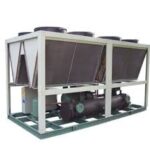
Water Cooled Chiller
Water Cooled Chillers are refrigeration systems that use water as a cooling medium to transfer heat away from the refrigerant. They are widely used in large-scale industrial

Screw Chiller
Screw Chillers are a type of refrigeration system used for air conditioning or industrial cooling applications. They operate using screw compressors, which are efficient at handling large cooling loads.
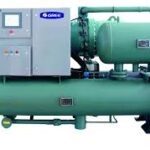
Variable Speed Chiller
Variable Speed Chillers are refrigeration systems equipped with compressors that have variable frequency drives (VFDs). These drives enable the compressor motor to adjust its speed according to the cooling load demand.
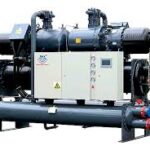
Oil Chiller
Oil Chiller are refrigeration systems designed to control and maintain the temperature of lubricating oil used in industrial machinery and processes. They ensure that the oil remains within a specified temperature range
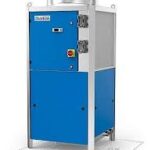
Hydraulic Oil Chiller
Hydraulic Oil Chillers are specialized refrigeration systems designed to cool and maintain the temperature of hydraulic oil used in hydraulic systems. They ensure that the oil remains within a specified temperature range
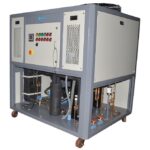
Online Chiller
Online Chiller is a refrigeration system designed to provide continuous cooling for industrial or commercial applications. It is equipped with capabilities for remote monitoring and control through internet connectivity
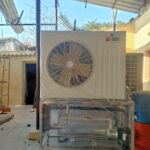
Glycol Chiller
Glycol Chiller is a type of cooling system that uses a glycol-water mixture as the coolant to remove heat from a process or equipment. Glycol chillers are commonly used in applications where maintaining a consistent
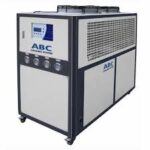
Spindle Chiller
Spindle Chiller are specialized cooling systems designed to manage the temperature of the spindle in machinery, such as CNC (Computer Numerical Control) machines.
